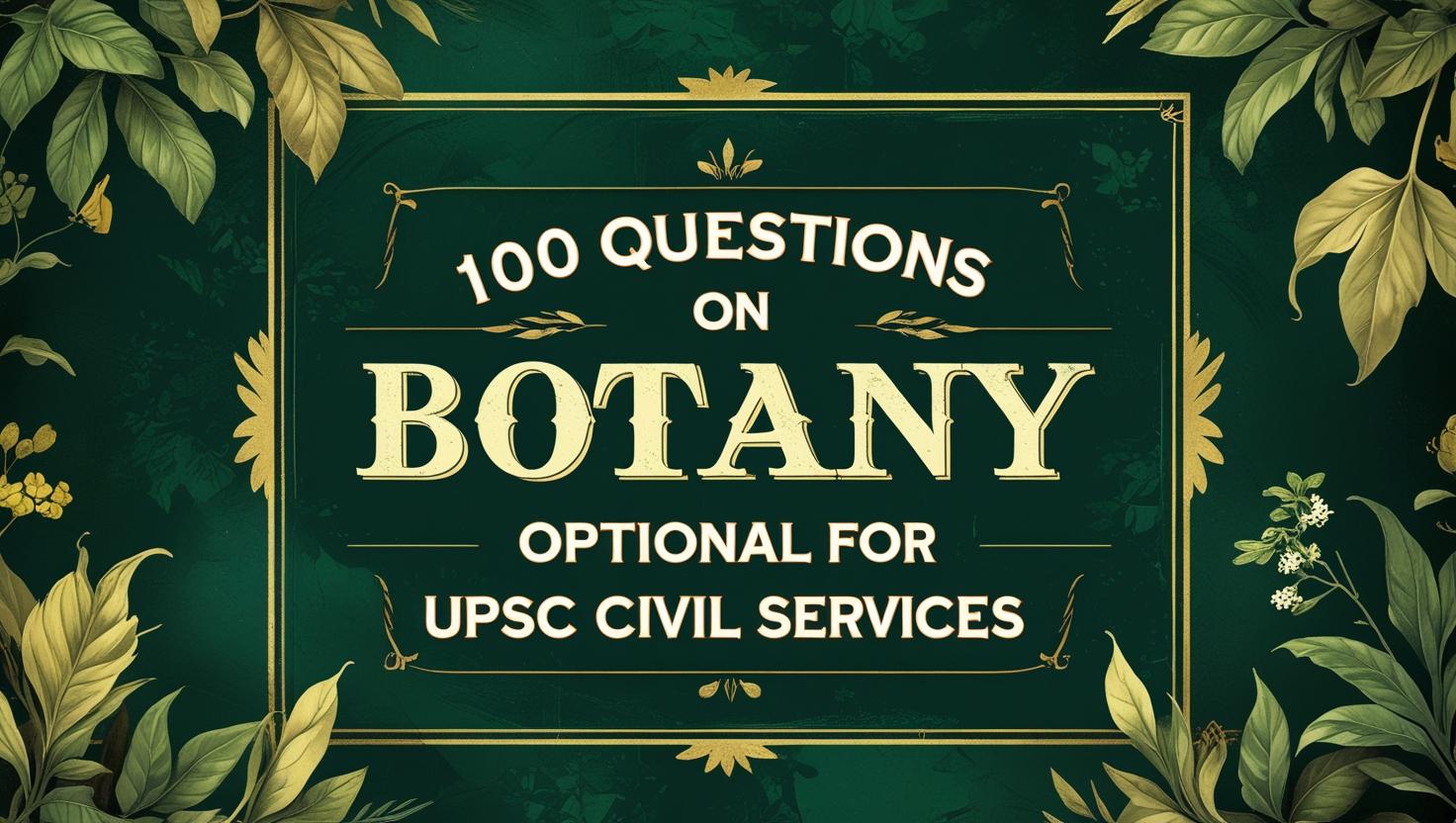Introduction
Botany is a significant optional subject for UPSC Civil Services aspirants who have an academic background in life sciences. It offers a scientific approach and a structured syllabus that can be mastered with conceptual clarity and practice. This compilation of 100 important questions, divided according to the UPSC Botany syllabus chapters, will help candidates practice and refine their understanding for the mains examination.
For UPSC Coaching , Join FIRST IAS INSTITUTE (India’s Top IAS Coaching)
Chapter 1: Microbiology and Plant Pathology
- Describe the structure and reproduction of bacteria.
- Discuss the role of viruses in plant diseases.
- Explain the economic importance of fungi.
- Describe the ultrastructure of a bacterial cell.
- Differentiate between lytic and lysogenic cycles of bacteriophages.
- Write notes on nitrogen-fixing bacteria.
- Discuss the pathogenicity of fungal diseases in plants.
- Explain the role of mycorrhiza in plants.
- Discuss the process of fermentation by microorganisms.
- Write about the control measures of plant viral diseases.
Chapter 2: Cryptogams
- Describe the life cycle of Rhizopus.
- Explain the reproduction in Algae.
- Describe the alternation of generations in Bryophytes.
- Discuss the classification of Algae.
- Explain the characteristics of Pteridophytes.
- Write about the structure of Marchantia.
- Compare the gametophyte and sporophyte in Bryophytes.
- Discuss the ecological importance of Algae.
- Describe the evolutionary significance of Pteridophytes.
- Write a note on heterospory in Pteridophytes.

3: Phanerogams
- Describe the reproductive structures of Gymnosperms.
- Explain the classification of Angiosperms.
- Discuss the theories of angiosperm evolution.
- Explain the process of double fertilization in Angiosperms.
- Write about the economic importance of Gymnosperms.
- Describe the floral morphology of Leguminosae.
- Write about the features of Monocots and Dicots.
- Explain the importance of floral diagrams and floral formulae.
- Discuss the concept of APG system of classification.
- Explain the evolutionary trends in floral morphology.
Chapter 4: Plant Anatomy
- Explain the structure of dicot stem.
- Write notes on xylem and phloem.
- Describe the structure of root apical meristem.
- Explain the anatomy of monocot leaf.
- Discuss secondary growth in dicot stems.
- Describe the differences between heartwood and sapwood.
- Explain the structure of vascular cambium.
- Discuss the role of stomata in plants.
- Describe the adaptations of xerophytic leaves.
- Explain the anatomy of dorsiventral leaf.
Chapter 5: Plant Embryology
- Explain the process of microsporogenesis.
- Discuss megasporogenesis in Angiosperms.
- Describe the types of ovules.
- Write about the development of the embryo sac.
- Explain fertilization in flowering plants.
- Discuss the development of dicot embryo.
- Describe endosperm development.
- Explain apomixis and its significance.
- Write about polyembryony.
- Discuss incompatibility mechanisms in plants.
6: Plant Physiology
- Explain the process of photosynthesis.
- Write about C3, C4, and CAM pathways.
- Discuss photorespiration.
- Describe the mechanism of mineral absorption.
- Write about translocation of solutes in phloem.
- Explain water potential and its components.
- Discuss plant growth regulators.
- Describe the process of seed dormancy and germination.
- Explain the nitrogen cycle in plants.
- Discuss the role of enzymes in plant metabolism.
Chapter 7: Genetics, Molecular Biology, and Evolution
- Explain Mendel’s laws of inheritance.
- Discuss linkage and crossing over.
- Describe the structure of DNA.
- Explain the process of transcription.
- Write about genetic code and its properties.
- Discuss protein synthesis in eukaryotes.
- Explain mutations and their types.
- Discuss the concept of genetic engineering.
- Explain the Hardy-Weinberg principle.
- Write about molecular evidence of evolution.

Chapter 8: Plant Breeding, Biotechnology, and Biostatistics
- Discuss the principles of plant breeding.
- Write about hybridization techniques.
- Explain the role of polyploidy in crop improvement.
- Describe tissue culture techniques.
- Discuss transgenic plants and their applications.
- Write about molecular markers in plant breeding.
- Explain the concept of quantitative inheritance.
- Describe statistical methods in analyzing plant data.
- Write about the applications of CRISPR in plants.
- Explain the use of micropropagation in agriculture.
9: Ecology and Environment
- Explain the concept of ecosystems.
- Write about ecological succession.
- Discuss biogeochemical cycles.
- Explain the structure of a food chain and food web.
- Describe the concept of ecological pyramids.
- Write about biodiversity hotspots in India.
- Explain plant adaptations to aquatic environments.
- Discuss pollution and its effect on plants.
- Describe the role of plants in climate regulation.
- Write about conservation strategies for endangered species.
Chapter 10: Economic Botany
- Write about food crops and their importance.
- Discuss the significance of medicinal plants.
- Explain the importance of fiber-yielding plants.
- Write about oilseed crops and their uses.
- Discuss plantation crops and their significance.
- Explain the role of pulses in Indian agriculture.
- Describe the economic importance of timber plants.
- Write about beverage-yielding plants.
- Explain the role of horticultural crops in economy.
- Discuss the role of biofuels and biofertilizers.
Conclusion
Botany optional is a scoring subject in the UPSC Civil Services Examination when studied systematically with conceptual clarity. These 100 questions, divided across the key chapters of the syllabus, provide aspirants with a solid base for answer writing practice. Consistent practice and integration of diagrams in answers can significantly improve performance and ensure better scores in the examination.
Also Visit – Best IAS Coaching in India
For Answer Writing Techniques – Join FIRST IAS INSTITUTE

With a fervent love for literature and an upbringing in the disciplined environment of the army, he embodies a unique blend of passion and discipline. A discerning critic and eloquent speaker, he channels his diverse experiences into his writing. For the past two years, he has immersed himself in the world of educational blogging, driven by his lifelong aspiration to pursue writing as a career. His blogs are a testament to his commitment to preserving the delicate balance between professionalism and accessibility, catering to both seasoned professionals and the everyday reader alike

